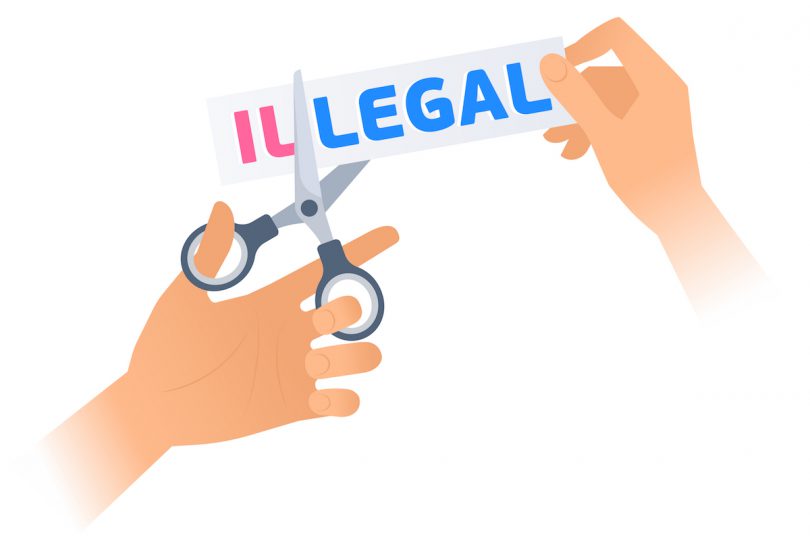PR practitioners are required to act ethically in all communications.
However, in the digital age sometimes well-intentioned ethical communication can still run afoul of copyright law. Because of the fluidity of social media communication, and the inherent structure of platforms that rewards sharing and modifying content, sometimes PR practitioners end up violating copyright law unintentionally.
Intent is not an element of copyright infringement, though. Instead the best defense to an infringement issue is having a core foundation of copyright knowledge to know have to share, modify, and protect original content.
There is a rather low threshold for something to receive copyright status. Under U.S. law all that is required for something to receive copyright protection is that it be original and fixed in a tangible medium. Originality under the law means there is at least some degree of creativity.
As you can imagine, this includes many different types of works, and under the U.S. Code includes: literary, musical, dramatic, pantomimes/choreographs, pictorial/graphic/sculptural work, motion pictures, sound recordings, and architecture. The fixation requirement is also very general. It only requires that the work be placed in a tangible medium. This includes traditional formats, such as paper, but also digital.
The biggest issue in copyright infringement is knowing when a work is under copyright protection. This requires some knowledge of when a copyrighted work was made. Two statutes govern this: the Copyright Act of 1909 and the Copyright Act of 1976.
Works made prior to 1978 are governed under the 1909 statute (along with amalgam of other laws) and works after 1978 are governed under the 1976 statute. Those works governed under the 1976 statute enjoy protection for life or the author plus 70 years, or if it is a work for hire 120 years from creation. If a work is pre-1978 the duration of copyright varies according to whether the owner of the work complied with certain formalities required under the older copyright law (“Duration of Copyright,” 2011).
When a work is copyrighted it doesn’t mean that it cannot ever be used by someone other than the owner. Frequently owners will grant permission for use, and, as is the purpose behind copyright protection, owners of copyrighted work can get paid for licenses for use.
As PR practitioners using, and protecting, copyright is important. There are four major copyright issues that practitioners should be aware of.
1. Be careful about social media sharing: Social media is designed to facilitate interaction between user content. In fact, when that content is posted on social media accounts the owner gives up some control over how it can be used.
However, PR practitioners should be cautious about sharing photos or other content that they do not own. This includes taking pictures of pictures, or scanning content from other sources and posting. Sharing already posted content on social media may also constitute infringement in some circumstances.
Fair use (discussed below) may apply to that situation, but if the use of the shared post is designed to generate profits and would normally be something that would require permission offline then it could be infringement.
The issue with sharing is the speed at which it happens. Sharing is so simple and easy to do, but with sharing social media content practitioners need to think about potential infringement first.
2. E.U. laws are changing copyright: As PR work becomes increasingly international it is important to think about legal implications beyond a U.S. context.
In 2019, the European Union implemented new copyright laws that made it a requirement for content providers, such as social media organizations, internet service providers and search engines, to screen content that is potentially copyright infringement. This law is still in its beginning stages, and E.U. member states have until June 2021 to pass laws to reflect this new E.U. directive.
Content providers will likely have to implement a screening system to comply with these laws. These screens may be imprecise, and screen out content that is otherwise protected. That means memes, gifs, and other content on social media that is normally protected under the law could be screened out initially and only re-posted after review.
For PR practitioners practicing in the EU, this new law could mean more protection for their organization’s copyrighted content, but it also means social media strategy can change.
3. Be careful about relying too much on fair use. One of best known and misunderstood aspects of copyright infringement is fair use found in 17 U.S.C. §107.
Part of the reason it is so well-known is fair use is a complete defense to copyright infringement. But it is important to remember it works only in certain contexts. In addition, fair use is a defense raised in response to an infringement claim. Because of that, asserting fair use is something that first requires a lawsuit alleging infringement; only then can the alleged infringer claim fair use.
When assessing whether fair use applies courts look to four factors: 1) purpose and character of the use, 2) nature of the copyrighted work, 3) amount of copyrighted work used, and 4) the impact of the use on the copyrighted work’s value. None of these elements are dispositive, and all are analyzed equally. However, in 1985 the U.S. Supreme Court in Harper and Row v. Nation Enterprises suggested the fourth element, impact on value, is the most dispositive of whether fair use applies. The Supreme Court later in 1994 backed away from that assertion in Campbell v. Acuff Rose Music Enterprises, but the impact on market is important.
PR practitioners should look at potential use of copyrighted material and ask what is the true reason behind their use. The more commercial the use, and the more likely it is going to affect the value of the copyrighted work and potential royalties, the less likely it is fair use.
Also, just because the organization using the copyrighted material is a non-profit or an educational institution does not mean the use is presumptively fair use. When in doubt, get permission from the copyright owner. The royalty will likely be less costly than the lawsuit.
4. There is a difference between copyright infringement and plagiarism. Frequently copyright and plagiarism are discussed together, and while they are related, they are not the same.
Plagiarism is the unauthorized use of another’s work without attribution, and is a textbook example of unethical communication practice. Copyright infringement is the unauthorized use of a copyrighted work without the owner’s permission despite attribution. Many people think that providing proper attribution saves them from a copyright claim.
While that may be a mitigating factor for infringement damages, it is not a defense to copyright infringement. Proper attribution is not what infringement is about; instead infringement is about unauthorized use, which affects the owner’s ability to make money off his or her intellectual property.
This is just an overview of many of the copyright issues facing the communications industry. Of course, if you have a copyright issue be sure to contact your legal counsel to make an informed and legally sound decision. However, the best way for PR practitioners to handle copyright issues is to have a working knowledge of the law.
Even though you may not have the right legal answer to every copyright issue, the biggest challenge is identifying potential infringement. Knowing this allows practitioners to be better, ethically and legally, when dealing with content.
Cayce Myers, Ph.D., LL.M., J.D., APR, is an associate professor at Virginia Tech in the Department of Communication where he teaches public relations. His research focuses on how laws affect PR practice. He currently serves on BEPS and is the legal research editor for the Institute for Public Relations. Contact Cayce at mcmyers@vt.edu or follow him on Twitter at @CayceMyers.








Thank you for this informative article. I’d like to know about a prevalent type of content on social media. Some for-profit organizations share news articles on their official social media accounts via URLs. The social media automatically generate a preview via URLs. I understand this to be a type of cited sharing, but should official accounts refrain from sharing this copyrighted material on their official accounts? Is it a grey area that is mostly overlooked by the content owners?